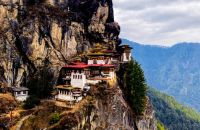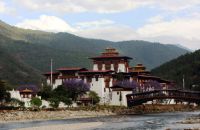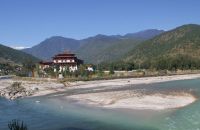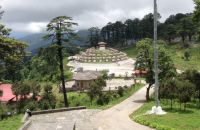Talk with our local travel specialist who can help organize your trip.
How to see black-necked cranes festival in Bhutan
The raven might be the official national bird of Bhutan – its image appears on the royal crown and it’s said to represent one of the main guardian deities of the country – it is by no means the country’s favourite bird. That honour falls to a far more graceful avian figure: the black-necked crane.
The Bhutanese are so fond of these distinctive wading birds that a major festival is held each year in their honour. But, black-necked cranes, which are considered Near Threatened by the IUCN, are only present in Bhutan at very specific times of year and only in certain valleys. So, how can you see black-necked cranes in Bhutan? Grab your binoculars and let us guide you to the best places in Bhutan to see black-necked cranes!
Table of Content
- What Is The Black-Necked Crane?
- Why Is The Black-Necked Crane Special To The Bhutanese?
- How Many Black-Necked Cranes Are There In Bhutan?
- When Can You See Black-Necked Cranes In Bhutan?
- Where Can You See Black-Necked Cranes In Bhutan?
- What Is The Black-Necked Crane Festival?
- Is There Any Kind Of Black-Necked Crane Information Centre In Bhutan?
- What Else Can I See And Do In The Phobjika Valley?
- Where To Stay In The Phobjika Valley?
What is the black-necked crane?
This elegant bird, which stands a little over a metre high and can weight over 5kg, is unmistakable. It has a sooty white body with a velvet black neck and tail and a deep red patch on the top of its head. Preferring marshy areas, it has long ballerina legs (and yes, like all cranes, it does dance!) to help it move through its swampy feeding grounds. It also has a long, dagger-like bill, which it uses to catch insects, fish, frogs and to ferret around for roots and tubers.
A migratory bird, that often pairs for life, there are two distinct populations of black-necked crane. One in central China and another that breeds on the Tibetan plateau, but (sensibly we think) this one flees the bitter Tibetan winter by flying south over the Himalaya to Bhutan, and a few other parts of the southern foothills of the Himalaya.
If it can fly over the world’s highest mountains then clearly the black-necked crane is as comfortable in the air as a jumbo jet. But, it’s also pretty nifty on the ground as well. Those long legs mean that when it wants too it can easily outrun a human!
Why is the black-necked crane special to the Bhutanese?
Black-necked cranes have long been considered culturally important to the Bhutanese, as well as to other peoples in Asia. They have been revered by Tibetan Buddhists for centuries with legend saying that previous incarnations of the Dalai Lama were carried from monastery to monastery on the backs of these holy birds. It’s said that they come from the heavens as avatars of ancestors and passed loved ones.
To the Bhutanese then, the birds signify longevity, peace, and prosperity. It’s for this reason that you will sometimes see them painted on houses and shops throughout the country. In certain parts of Bhutan, such as the Phobjikha valley, farmers believe the presence of the birds each winter will ensure a good harvest the following year.
Featured Trips

Black Necked Crane Festival Tour - 8 days
Black Necked Crane Festival Tour in Bhutan lets you traverse into the Gangtey Nature Trail in central Bhutan while attending the Black Necked Crane Festival celebrated to welcome the rare creatures in the Phobjikha Valley.
Inquire Now
Thimphu Festival Tour - 8 days
Thimphu Festival tour is the best way to explore the rich culture of Bhutan is perhaps to attend its annual Thimphu Festival, which is possible through this 8-day tour.
Inquire NowWhere to travel next?
Get help from our travel specialists for holiday ideas that matches your interests.
How many black-necked cranes are there in Bhutan?
Although black-necked cranes are classed as Near-Threatened by the IUCN, thanks to increasing conservation efforts the worldwide population is increasing. In the year 2000 there was an estimated world population of just 6000. Now there are an estimated 17,000 individuals (2022 figures). Around 600 of these birds spend the winters in Bhutan.
Although this might not seem like very many the number passing the cold season in Bhutan has been steadily rising over the past decade or so thanks to on-going conservation efforts. According to Bhutan’s Royal Society for the Protection of Nature, in 2023 a total of 676 cranes overwintered in the country, up 12 percent from the previous year when 599 were recorded.
Although populations are rising that doesn’t mean the black-necked crane is out of trouble. According to WWF Bhutan, threats the birds face include habitat loss, predation by domestic and feral dogs, and climate change.
When can you see black-necked cranes in Bhutan?
Black-necked cranes are a migratory species which means that they spend half the year in one area and then, when weather and food conditions change there, they fly to another region where the living is easier. In the case of the black-necked cranes that come to Bhutan they spend the warmer months of the year on the high Tibetan plateau where they breed.
Then as things cool down in Tibet they fly south over the Himalaya to Bhutan. The exact arrival date is of course weather dependent but is roughly late October and they remain in Bhutan until the end of February after which they head back over the Himalaya and into Tibet.
Where can you see black-necked cranes in Bhutan?
Cranes are rather fussy about where they over winter. In Bhutan, they prefer the lower, warmer valleys with ample wetlands and, crucially, wheat and barley fields that have been left fallow for the winter. These fields normally contain lots of left over seeds that the cranes can feast on and quickly fatten up on. In Bhutan, small numbers of black-necked cranes have been recorded in Bumdeling in Tashi Yangste and Bumthang Valley.
However, it’s the beautiful Phobjikha valley in central Bhutan that most reliably attracts large numbers of cranes. It’s said that when the first cranes arrive in Phobjikha that they circle the Gangteng Monastery three times in a kind of air-borne kora. They are then supposed to repeat this act when, at the end of winter, they flap away back north to Tibet.
The local human population in Phobjika is particularly welcoming to the cranes with many villagers even leaving out food for the birds. This means that the birds are fairly relaxed around people which in turn allows bird watchers to get reasonably close to these normally nervous birds. To encourage international bird watchers, several well-positioned bird observation hides have been set up around the valley and local guides are always on hand to show visitors the current best spots to see the cranes from.
So important have the cranes become to the people of the Phobjika valley that a special festival, that has both religious and secular elements to it, is now held every year in the Phobjika Valley to celebrate the arrival of the birds.
What is the black-necked crane festival?
Held on November 11th every year, the Black-necked Crane Festival takes place in the courtyard of the Gangteng monastery in the Phobjika Valley. The festival, which celebrates the arrival of the birds into the valley at the start of each winter, features traditional cham dances (masked dances) performed by monks and lay people wearing ornately carved masks representing different deities. The highlight of the festival though is when local school children, dressed in black-and-white costumes, enact the flight of the cranes into the valley.
In addition to this spectacle various environmental programes are held to teach people about the value of the cranes. In the few years the festival has been running it has quite rightly become one of the most popular with international visitors to Bhutan. If you’re intending to visit during this period book your tour as early as possible as there’s only limited accommodation within the valley.
Is there any kind of black-necked crane information centre in Bhutan?
Yes! The Royal Society for the Protection of Nature operates a museum and black-necked crane information centre within the Phobjika Valley and a visit is a part of all Third Rock Adventures tours to Phobjika. The centre also cares for and rehabilitates any injured cranes (and other wildlife) so a visit is a great way of getting a close-up view of these wonderful birds.
Featured Trips

Gomkora Tshechu Festival Tour - 13 days
Gomkora Tshechu Festival Tour observers the annual Gomkora festival in the Gomphu Kora situated at Trashigang in the eastern Bhutan. The 13 days tour is not just limited to eastern Bhutan it is also visiting the cultural icons of Bhutan
Inquire Now
Druk Wangyel Festival Tour - 7 days
Druk Wangyel Festival Tour set in the western region of Bhutan offers a distinct experience of witnessing the true traditions and beliefs sewn in the festival celebrated at the heights of Dochula Pass.
Inquire NowWhere to travel next?
Get help from our travel specialists for holiday ideas that matches your interests.
What else can I see and do in the Phobjika Valley?
There’s more than just black-necked cranes to Phobjika’s wildlife checklist. The marshes and wetlands within the valley are a Ramsar wetland site and there are at least 13 other globally threatened bird species present within the valley including imperial and greater spotted eagles, Blyth’s tragopan, wood snipe, and chestnut-breasted partridge.
Away from the birds the valley also hosts leopards, muntjacs, sambar and black bear. You don’t have to be a wildlife watcher to enjoy the Phobjika Valley though. In fact, even without the cranes, we rate this as one of our favourite spots in Bhutan. The wide valley, which is hemmed by the forested Black Mountains, offers some fantastic day walks to viewpoints and small shrines and monasteries. The most impressive site though is the Gangtey Monastery.
Dating from the 17th Century, the monastery is the main seat of the 9th reincarnation of the Terton (treasure seeker – more about these in a later blog post), Pema Lingpa. Inside the four-storey complex, there are some superb statues of Guru Rinpoche and other deities as well as some well-preserved frescos. Once you’ve finished exploring the monastery and meeting the hundred or so permanent monks head out on the short nature trail that leads away from the mani wall at the monastery before wending its way through Semchubara village to end at Khewang Lhakhang (another monastery).
Where to stay in the Phobjika Valley?
There are several atmospheric and comfortable homestays in the valley, which Third Rock Adventures can book for you. These offer a great insight into local life but don’t expect private bathrooms and much in the way of winter heating! There are also several tourist-class hotels which offer more comfort than the homestays but less experience. And then there’s the simply fabulous Gangtey Lodge, which is widely considered to be one of the best hotels in Asia.
A stay here does not come cheap but if you’re going to splash out on a night of luxury anywhere in Bhutan (and you really should) then this is the one to do it at. We can arrange a stay for you.
As you will now understand, for the Bhutanese the raven might well be the national bird, but it’s the black-necked crane that is the bird of the people. And getting to see the black-necked crane in Bhutan might well turn out to be an unexpected highlight of your adventure in the Land of the Thunder Dragon.
- Written by: Naba Raj Amgai
Updated: Oct, 30, 2024




























